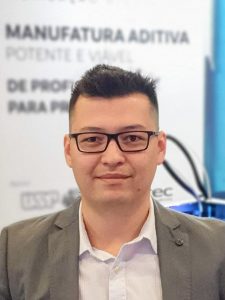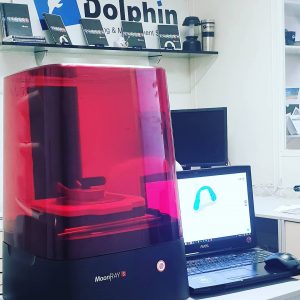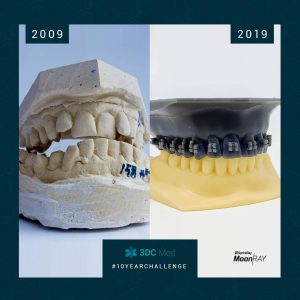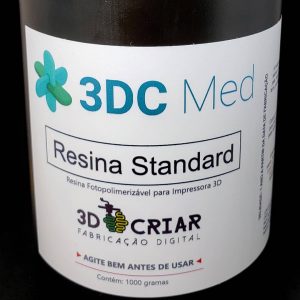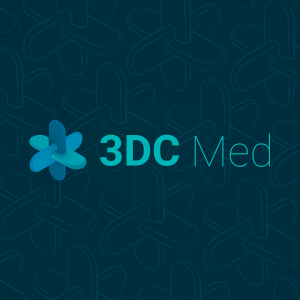 Today, Brazil is one of the countries with the most dentists in the world. With over 190,000 dentists (that’s 111 dentists for every 100,000 people), it’s no wonder the dental industry has been heavily influenced by 3D printing. It’s right up there with the United States, Israel, Finland, and Estonia. Just like everywhere else in the world, it allows the creation of a variety of dental pieces, such as night guards and aligners, dentures, surgical guides and molds, the production of drill guides for dental implants, physical models for prosthodontics, orthodontics, the manufacture of dental, craniomaxillofacial and orthopedic implants, as well as the fabrication of copings and frameworks. Along with new 3D software, scanners, and 3D printers. Brazilian company 3DC Med provides state-of-the-art equipment, including 3D scanning and printing technologies for digital dentistry and medicine, as well as specific consultancies and training to guarantee that the professionals who purchase the machines will use them correctly. For Chief Technology Officer of 3DC Med, Daniel Huamani, “the notion of digital dentistry involves much more than the purchase of machines and software, it’s about educating professionals on the potential uses of the technology.”
Today, Brazil is one of the countries with the most dentists in the world. With over 190,000 dentists (that’s 111 dentists for every 100,000 people), it’s no wonder the dental industry has been heavily influenced by 3D printing. It’s right up there with the United States, Israel, Finland, and Estonia. Just like everywhere else in the world, it allows the creation of a variety of dental pieces, such as night guards and aligners, dentures, surgical guides and molds, the production of drill guides for dental implants, physical models for prosthodontics, orthodontics, the manufacture of dental, craniomaxillofacial and orthopedic implants, as well as the fabrication of copings and frameworks. Along with new 3D software, scanners, and 3D printers. Brazilian company 3DC Med provides state-of-the-art equipment, including 3D scanning and printing technologies for digital dentistry and medicine, as well as specific consultancies and training to guarantee that the professionals who purchase the machines will use them correctly. For Chief Technology Officer of 3DC Med, Daniel Huamani, “the notion of digital dentistry involves much more than the purchase of machines and software, it’s about educating professionals on the potential uses of the technology.”
“Today, maybe just 5% of Brazilian dentists have had any contact with digital dentistry before graduating, which is why we sell the machines and train them to use them,” explained Huamani to 3DPrint.com. “A few years ago, dentists would ask if we could print teeth with the printers, and when we said no, they pretty much lost interest. So we are telling them that 3D printers are great for a variety of surgical guides, temporary crowns or bridges.”
Huamani explains that the company “doesn’t like to push technology into the market without first teaching them how to use it.” When they began working with the dentistry industry some years back, they found an incipient market that had tried to succeed by pushing the technology everywhere, without training or consultation, leading to lots of mistakes in the printing process, which “was bad for the market in general.” Huamani claims that “he tends to disappoint dentists” when they first approach 3DC Med. He recommends that they start small and then build on.
“They usually want to begin by creating every type of dental piece possible, which means that they would need to buy between three or four different 3D software packages, and learn how to use each of them,” he said.
According to the engineer, the 3D dentistry market in Brazil has become more mature in the last two years, ahead of the rest of the Latin American community, but, as usual, lagging behind the more developed countries. Many more dentists understand today what they can do with 3D printing and how to do it, thanks to an overflow of information and published material on the technology, along with more education. Yet Huamani suggests that there are a few gaps, not with the printer but with the CAD software which he says “is a great barrier to dentists, a profession that has not been originally used to anything digital and needs to figure out that if something bad comes out of the printer it’s not the machines’ fault, but usually the scan or the CAD preparations were wrong.”
3DC Med is a sister company of the 3D Criar group, which recently participated in the fifth edition of the Inside 3D Printing Conference & Expo, in Sao Paolo, Brazil, one of the world’s leading 3D printing events in South America. It was originally developed to provide the dental and medical sector with high technology equipment and consultants with unique expertise in the market, so it’s not just about dentistry. Their team of experts helps with the end-to-end implementation, from choosing the right equipment and software to proper solution training. In the case of dentistry, 3DC Med sells Mask Image Projection Stereolithography (SLA) Digital Light Processing (DLP) machines, which they consider the definitive 3D technologies for digital dentistry due to their precision. 3DC Med is the official reseller for Sprint Ray’s MoonRay 3D printers (both MoonRay D75 and MoonRay S100). Also, they provide resins (both national and international), intraoral scanners (French-made Carestream Dental), and can recommend software based on the customer’s needs. 3D printing is a fast-growing technology in various fields, including dental laboratories. Dental 3D printers feature lights or lasers that polymerize a liquid or fuse a powder with the computer-guided precision needed to produce small objects with complex details.
“Our experience with intra oral scanners has proven that they work really well. But I’m very realistic, so I understand that they are excelent at scanning teeth, and nothing else. At 40,000 dollars a scanner, they will serve that one purpose. At 3DC Med we believe in the scanning technology, but only when applied to the correct end use. Dental scanners are good technology, since they give professionals a faithfull idea of what they need to print out,” said Huamani.
3DC Med will help dentists go from A to Z of the process, teaching them everything they need to know to avoid any costly mistakes. So, how do dentists combine the technology to come up with customized pieces in shorter time periods and at a lower cost?
According to a recent study, when manufacturing a complete denture using digital workflow, the process begins with digital scanning of the edentulous arch, including challenging areas for the intraoral scanner device to scan, which are movable areas such as non-keratinized tissue and smooth surfaces covered with saliva. Once they get everything right, they use dental modeling software to modify and adapt the denture, then they need to choose a resin. Depending on the application, different resins are used, and many specialized resins have been created solely for dental 3D printers. The Sao Paolo-based company offers 10 different types of resins on their online site, including resins for making surgical guides, others to manufacture plates, denture bases, and temporary teeth. Some of their customers include the University of São Paolo, Orto3D, the University of Rio de Janeiro, Clélio Laboratory, Unicamp, Mediphacos, Unicad, Hospital de Clinicas in Porto Alegre, Aprimora Clinic, and Fenelon Radiology.
“Dentistry has reached an ideal stage. In the last few years, the hardware hasn’t changed dramatically, but we are finding new materials, software, and even new players. The fact that the technology in itself is still the same as it was two years ago, is a good thing, it means that it is finally established as a great means for the end users, they are fast and easy to use. I don’t think 3D printing in dentistry will change so much in the future, but of course, it will get faster, and the machines will probably remain at today’s prices. I do believe that the software will play a major role in how things are created, what kind of support is needed and how intuitive it will be. Definitely, materials will be better too, ideally for permanent restorations and invisible aligners,” he continued.
3DC Med was also created to provide solutions and tools for 3D printing in the medical community. However, there is a big barrier to what they can do with a printer. The country has regulations that won’t allow for 3D printed implants just yet, which means you take away a lot of the fun of additive manufacturing in hospitals. So what’s left for the company and the industry is to move to presurgery models in Brazil. Still, like in the rest of the region, nobody wants to pay for them, not the patients, or the hospitals, health insurance companies or even the State. It is still not clear for them how beneficial they can be to both doctors and patients. But as with dentistry, Huamani believes that the use of CAD is a big problem here as well.
“Hospitals don’t have someone specialized who could use the software and 3D printers every day, which means they would require a biomechanical engineer.”
3D printing is revolutionizing healthcare whether some people like it or not. Hospitals around the globe are setting up 3D printing labs so that healthcare professionals can incorporate the process into their regular workflow, focusing on printing patient-specific models prior to surgery to look at a patient’s anatomy. Brazil has quite a large market, with over 209 million people, an economy ranked as the world’s ninth largest, in terms of nominal GDP, and a demonstrated potential for even further growth in many industry sectors, paving the way for additive manufacturing to become part of healthcare, dental, and many other industries that would heftily benefit from it.
[Images: 3DC Med]Subscribe to Our Email Newsletter
Stay up-to-date on all the latest news from the 3D printing industry and receive information and offers from third party vendors.
You May Also Like
Precision at the Microscale: UK Researchers Advance Medical Devices with BMF’s 3D Printing Tech
University of Nottingham researchers are using Boston Micro Fabrication‘s (BMF) 3D printing technology to develop medical devices that improve compatibility with human tissue. Funded by a UK grant, this project...
3D Printing Webinar and Event Roundup: April 21, 2024
It’s another busy week of webinars and events, starting with Hannover Messe in Germany and continuing with Metalcasting Congress, Chinaplas, TechBlick’s Innovation Festival, and more. Stratasys continues its advanced training...
3D Printing Webinar and Event Roundup: March 17, 2024
It’s another busy week of webinars and events, including SALMED 2024 and AM Forum in Berlin. Stratasys continues its in-person training and is offering two webinars, ASTM is holding a...
3D Printed Micro Antenna is 15% Smaller and 6X Lighter
Horizon Microtechnologies has achieved success in creating a high-frequency D-Band horn antenna through micro 3D printing. However, this achievement did not rely solely on 3D printing; it involved a combination...


